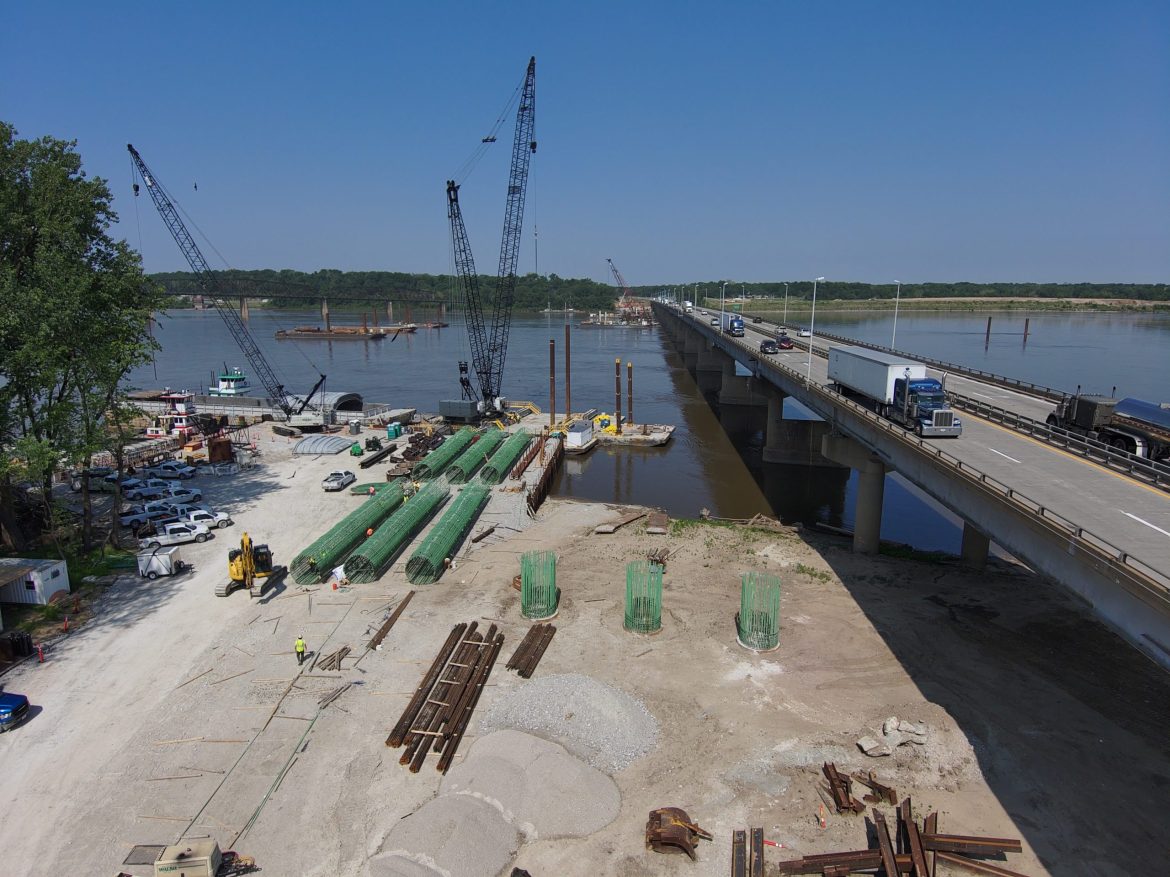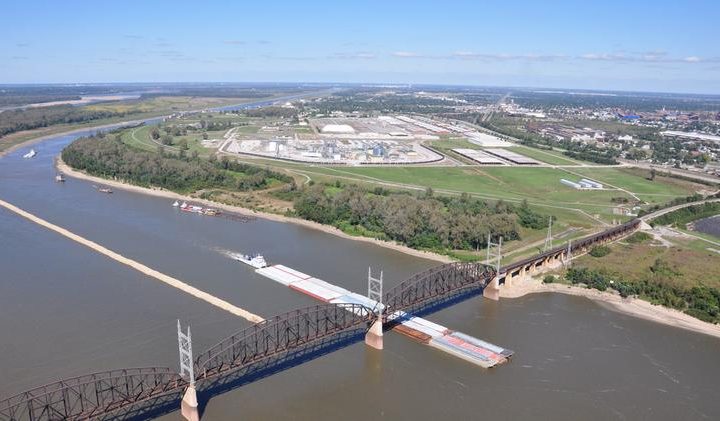
In a year marked with continuous supply chain disruptions, the St. Louis region achieved unprecedented collaboration and infrastructure advancements in 2023, reinforcing its role as a key player in the national and global freight network. The St. Louis Regional Freightway compiled a summary of some of the most significant developments that occurred in 2023 that either enhanced the region’s freight infrastructure or highlighted the strength of the bi-state area’s industrial market.
“St. Louis is a world-class freight hub, and we retain this position by constantly looking for ways to improve our freight infrastructure and strengthen our resiliency so this region is ready to deliver as supply chains continue to be impacted by any number of disruptions,” said Mary Lamie, Executive Vice President of Multi Modal Enterprises at Bi-State Development and head of the St. Louis Regional Freightway. “The investments made over the past year support future competitiveness and growth in the region.”
Topping the list of advancing projects is the new Chain of Rocks Bridge over the Mississippi River, which is currently under construction. The collaborative efforts of the Illinois Department of Transportation (IDOT) and the Missouri Department of Transportation (MoDOT) resulted in the successful planning and funding of the new bridge, which has an estimated cost of $496 million. Recognizing the importance of this bridge over the Mississippi River for the movement of freight through the region and the heartland of America, the St. Louis Regional Freightway has identified its replacement among the highest priority freight infrastructure projects for the past several years and helped to garner support for this project from the East-West Gateway Council of Governments. These efforts included collaboration with freight industry leaders, IDOT and MoDOT all supporting the project based on connectivity to other modes of transportation, such as rail, river and air, and the global access it provides to shippers and carriers.
“This collaborative, future-focused approach will ensure the project serves this region for decades to come,” Lamie said.
The bridge is part of a regional plan to improve a 22-mile section of Interstate 270 from James S. McDonnell Boulevard in Missouri to Illinois Route 157 in Illinois. To date, more than $1 billion in funding has been secured for this corridor for construction and partial design of new interchanges, additional traffic lanes and other interchange improvements, with some of that work already completed. In December, state and local officials celebrated the completion of a $278 million project that enhanced an eight-mile stretch of I-270 in north St. Louis County.
Several other projects identified as priorities by the St. Louis Regional Freightway also moved forward in 2023. Among these, more than $400 million in improvements to Interstate 70 are now funded, $233 million in improvements on I-55 from Route Z to U.S. Route 67 (MO) are moving forward, IDOT’s FY2024 – 2029 Proposed Highway Improvement Program includes $104 million for the Illinois Route 3 Connector, and $57.6 million has been committed for rehabilitation of the MacArthur Bridge at St. Louis. Additional projects are supporting critical first mile/last mile connections that serve the bi-state region’s thriving industrial parks. Collectively, these investments aim to enhance safety, reliability, and intermodal connections, fostering economic growth and job creation in the region.
The St. Louis region now has more manufacturing space available on the market compared to other Midwest cities, along with one of the lowest average asking rents. In addition, the region has trained workers ready to support newcomers to the industrial market with 15% of the region’s workforce within the production and transportation/material moving occupations. The 2023 St. Louis Regional Industrial Real Estate Market Indicators & Workforce Report also showed that, within the entire St. Louis metropolitan region, manufacturing is the fourth largest
industry, and manufacturing workers in the St. Louis region are nearly 15% more productive than the national average.
Many of these manufacturing workers are in the aerospace industry, which was highlighted during the St. Louis Regional Freightway’s second annual Take Flight Forum on November 8. The event featured the directors from the five busiest airports in the St. Louis region and representatives from four of the area’s most significant aerospace manufacturing and service companies. The region’s aerospace manufacturing and aviation ecosystem, which already accounts for more than 330,000 jobs, is about to be further boosted by an estimated $5 billion in investments that are expected to create 1,000 new jobs in the bi-state area. The five airports contributing to those totals include St. Louis Lambert International Airport and Spirit of St. Louis Airport in eastern Missouri, and three southwestern Illinois airports – St. Louis Downtown Airport, MidAmerica St. Louis Airport and St. Louis Regional Airport. The featured tenants whose operations are factored into the total numbers include The Boeing Company, Gulfstream Aerospace Corp., West Star Aviation and AVMATS.
Through focused collaboration this past year, the St. Louis region’s Class I railroads and economic development organizations, brokers and bi-state business leaders worked with the St. Louis Regional Freightway to identify and start marketing the top rail-accessible industrial real estate sites in the region. They are also taking on previously overlooked sites that have potential for rail access. Twelve locations featuring heavy industrial user zoning are ready for developers who want to take advantage of the strong rail infrastructure and multimodal advantages in the bi-state area. Information about these sites can be found at https://www.thefreightway.com/real-estate/rail-access/.
“Essentially, we are streamlining site selection for rail-accessible industrial sites in the bi-state St. Louis region, creating a pipeline of rail-served sites for the future and spotlighting rail sites that are currently ready to go,” said Lamie. “The sites that made it onto our list include service by at least one of the region’s six Class I railroads that connect to the East, West and Gulf Coasts. Sites that include BNSF, Union Pacific, CSX and Norfolk Southern provide routes with high volume and scheduled service to East and West Coast ports. With help from the region’s four interstates and strategic location on the Mississippi River, 90% percent of freight from the St. Louis region moves throughout North America in two days and 100% in three days. This list is a new tool that will enhance our region’s economic development marketing efforts.”
In a unique initiative launched last spring, the St. Louis Regional Freightway also began offering riverboat cruises for students, educators and administrators to tour the Ag (Agriculture) Coast of America, a 15-mile stretch of the Mississippi River running through the St. Louis region. The Ag Coast is home to 16 barge transfer facilities that, at total capacity, can handle more than 150 barges per day, providing the highest level of barge-handling capacity anywhere along the Mississippi River. The cruises provide valuable insight into the region’s multimodal freight network and highlight its role as a logistics hub with global access, while spotlighting the many career opportunities available in the region’s transportation, manufacturing and logistics industries.
The advantages the St. Louis region offers to shippers and carriers were also front and center during FreightWeekSTL, which was held May 22 to 26. The event delivered insightful discussions and reports calling attention to a series of innovations, investments and collaborations that will make national and global freight movements more efficient. Industry leaders provided insight on what is shaping the future of the freight industry, from the digitalization of global waterways and advances in the commercial delivery of autonomous railcars to the efforts underway to create a Supply
Chain Information Highway – all which have ties to the St. Louis region and have the potential to dramatically improve the movement of freight in the future. They also talked about continuing investments in ports in the St. Louis region, major manufacturing expansions underway, the billions in infrastructure improvements that support the region’s multimodal connectivity and more. The St. Louis region’s pivotal role in these initiatives, coupled with a continuous commitment to infrastructure improvements, positions it for sustained growth.
Also in 2023, the St. Louis Regional Freightway and Terminal Railroad Association of St. Louis jointly received a 2023 Top Supply Chain Projects Award from Supply and Demand Chain Executive magazine for the $222 million Merchants Bridge replacement project. The replacement project doubled the capacity on the bridge, allowing two freight trains to cross the bridge over the Mississippi River at the same time and move freight faster, more cost effectively and more reliably than like at larger congested Midwestern rail hubs. The award recognizes projects optimizing, streamlining, and improving the supply chain.
“As we celebrate all of the accomplishments of 2023, the St. Louis Regional Freightway looks forward to continued success in fostering economic development, enhancing connectivity, and maintaining the region’s status as a global logistics and manufacturing hub,” Lamie said.




